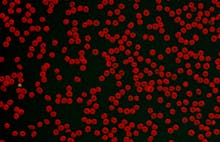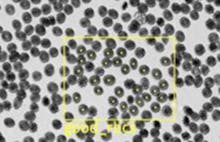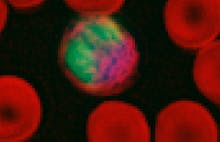Hemoglobin
Definition, Testing, Low vs High Levels, and CausesWhat is hemoglobin?
Hemoglobin is a protein molecule found in red blood cells (erythrocytes) that carries oxygen from the lungs to the rest of the body. Without hemoglobin, your red blood cells cannot deliver the oxygen that your cells need to produce energy. Hemoglobin is vital for human life.
Hemoglobin is a tetramer with four polypeptide chains — two alpha (α) and two beta (β) chains. Each of the polypeptide chains has a heme prosthetic group and an iron atom.
The heme group contains a red pigment called porphyrin. Iron attaches itself to porphyrin. When iron binds to oxygen, the porphyrin transforms blood into a vibrant red color. When it’s not bound to oxygen, it makes blood appear purplish-blue.
Each iron atom binds to one oxygen molecule. And since hemoglobin has four iron atoms, each one carries four oxygen molecules as it moves through your body.
In adults, the predominant hemoglobin is α2β2. It is also commonly called hemoglobin A1 (HbA).
Can hemoglobin be measured with a test?
The hemoglobin test is a common blood test that measures your hemoglobin count. It is typically measured as part of a complete blood cell count, along with hematocrit measurement.
To test, a laboratory technician or healthcare staff first cleans the area marked for collection. Next, they may prick your fingertip or insert a needle into a vein in your arm to collect a blood sample. Your sample is then sent to a laboratory for testing.
Your hemoglobin count gives you a direct measurement of the oxygen-carrying capacity of your blood.[1]
What is a normal Hemoglobin count?
According to the Cleveland Clinic, normal hemoglobin counts for adults are[2]:
- 14 to 17 gm/dL (grams per deciliter) of blood for men
- 12 to 15 gm/dL for women
What is a low hemoglobin count?
A low hemoglobin count is:
- 13.5 grams of hemoglobin per deciliter (135 grams per liter) of blood for men
- Less than 12 grams per deciliter (120 grams per liter) for women
What is a high hemoglobin count?
The threshold for a high hemoglobin count varies, depending on the medical practice.
In general, a high hemoglobin count is:
- More than 16.6 grams (g) of hemoglobin per deciliter (dL) of blood for men
- More than 15 g/dL for women
- In children, the definition of a high hemoglobin count varies with age and sex
What does it mean if your Hemoglobin is low?
A low hemoglobin count means that the oxygen-carrying capacity of your hemoglobin is reduced. Consult with your doctor if you suspect that your hemoglobin is low.
According to the Mayo Clinic, low hemoglobin levels can indicate that an individual has certain medical conditions, including [3]:
- Aplastic anemia
- Cancer
- Chronic kidney disease
- Cirrhosis
- Hodgkin’s lymphoma (Hodgkin’s disease)
- Hypothyroidism
- Inflammatory bowel disease (IBD)
- Iron deficiency anemia
- Lead poisoning
- Leukemia
- Multiple myeloma
- Myelodysplastic syndrome
- Non-Hodgkin’s lymphoma
- Rheumatoid arthritis
- Vitamin deficiency anemia
Researchers have also discovered that lower hemoglobin levels are associated with larger infarction at the time an acute ischemic stroke happens in a patient [4].
What does it mean if your Hemoglobin is high?
A high hemoglobin count is associated with high hemoglobin levels, which means that your hemoglobin has an increased oxygen-carrying capacity than normal.
A high hemoglobin level may indicate:
- Lung disease
- Heart disease
- Polycythemia vera
- Kidney tumors
- Dehydration
- Hypoxia
- Carbon monoxide exposure
- High altitude
What causes low or high hemoglobin levels?
Low or high hemoglobin causes are medical conditions that change the way your red blood cells behave or how many red blood cells you have at a certain time.
Sometimes, deficiencies in iron can cause your hemoglobin levels to decline. When your body’s iron concentrations are getting low, you may progress from mild iron deficiency to iron-deficiency erythropoiesis to iron deficiency anemia (IDA) [5]. IDA is typically characterized by low hemoglobin levels.
Hemoglobin concentrations lower than 11 g/dL in children under 10 years of age, or lower than 12 g/dL in individuals aged 10 years or older, are indicative of IDA [6].
How to increase your hemoglobin levels?
If you are experiencing symptoms that indicate low hemoglobin levels, consult with your doctor first to diagnose and confirm the cause of your symptoms.
If your doctor confirms that your hemoglobin levels are low due to a deficiency in iron, then you can increase your hemoglobin levels by eating iron-rich foods.
Iron deficiency can lead to low hemoglobin levels because hemoglobin contains iron atoms as one of its main components. In fact, approximately two-thirds of your body’s iron is found in heme.[7]
Certain people are more likely to have inadequate iron in their blood, including[5:1]:
- Pregnant women
- Infants and young children
- Women with heavy menstrual bleeding
- Frequent blood donors
- People with cancer
- People with gastrointestinal disorders or previous gastrointestinal surgery
- People with heart failure
Your doctor may recommend that you eat more foods containing iron. According to the NIH, foods rich in iron include:
- Lean meat – heme iron
- Seafood – heme iron
- Nuts – nonheme iron
- Beans – nonheme iron
- Vegetables – nonheme iron
- Fortified grain products (bread, cereals, and other grains) – nonheme iron
Heme iron has a higher bioavailability than nonheme iron. This means that sources of food with heme iron are more readily absorbed by hemoglobin. To get good absorption of the iron from nonheme iron sources, eat a lot of foods in this category.
Avoid foods that can prevent iron from getting absorbed. These include polyphenols (in certain vegetables), tannins (in tea), phytates (in bran), and calcium (in dairy products).[8]
For more specific iron-rich foods, check the NIH fact sheet. Your doctor may also prescribe iron supplements in addition to iron-rich foods.
Guidelines for iron supplements vary depending on the official recommending body. However, here are the iron supplementation guidelines from the US Centers for Disease and Control and Prevention (CDC)[5:2]:
- Infants exclusively breastfed and less than 4 months of age – no need to supplement with iron. Breast milk is sufficient
- Infants exclusively breastfed and 4 months of age or older: 1 mg/kg/day of standard over-the-counter iron drops
- Infants less than or 12 months of age who are not exclusively breastfed: iron-fortified infant formula
- Breastfed infants who were born preterm or with low birthweight: 2–4 mg/kg/day of iron drops (to a maximum of 15 mg/day)
- Women of childbearing age: 0.3–0.5 mg/day
- Pregnant women: an average of 3 mg daily over 280 days' gestation
If your doctor confirms that you have anemia, your low hemoglobin levels may be due to a lack of vitamin B12 or folate.
If so, your doctor may advise that you increase your hemoglobin with the following foods that are rich in both folic acid and vitamin B12:
- Eggs
- Meat
- Poultry
- Milk
- Shellfish
- Fortified cereals
Your doctor may also prescribe vitamin B12 shots and/or folic acid supplements if needed.
What is the difference between hemoglobin and hemoglobin A1C?
Normal hemoglobin is known as Hemoglobin A1 (HbA). However, there’s another type of hemoglobin known as hemoglobin A1c or glycated hemoglobin. Hemoglobin A1c is hemoglobin that has glucose attached to it.C
The higher your blood glucose level, the more chances that glucose will bind to your hemoglobin and convert it into A1c.
The hemoglobin A1c test is typically used to screen for and monitor diabetes. It can also check your risk of developing diabetes.
The A1c test is also done frequently to monitor glucose levels in people living with diabetes.
Hemoglobin Counter for Research
Researchers are constantly working on advancing traditional methods to measure hemoglobin. Earlier methods include the copper sulfate technique (CST), hemoglobin color scale (HCS), Sahli’s method, and cyanmethemoglobin method (CM).
CM is still the gold standard for measuring hemoglobin counts because of its accuracy. However, novel non-invasive methods to calculate hemoglobin counts include portable methods such as automated hemoglobin analyzers, HemoCue gravity method, and NBM 200.
Credit: Cover picture - Hemoglobin by Murtada al Mousawy is licensed under CC BY-NC-SA 2.0
Discover Sight's Automated CBC Analyzer
- Quintó L, Aponte JJ, Menéndez C, et al. Relationship between haemoglobin and haematocrit in the definition of anaemia. Trop Med Int Health. 2006;11(8):1295-1302. ↩︎
- High Hemoglobin Count: Causes, Treatments. Cleveland Clinic. Accessed May 31, 2021. https://my.clevelandclinic.org/health/diseases/17789-high-hemoglobin-count ↩︎
- Low hemoglobin count Causes. Mayo Clinic. Accessed May 31, 2021. https://www.mayoclinic.org/symptoms/low-hemoglobin/basics/definition/sym-20050760 ↩︎
- Kimberly WT, Wu O, Arsava EM, et al. Lower hemoglobin correlates with larger stroke volumes in acute ischemic stroke. Cerebrovasc Dis Extra. 2011;1(1):44-53. ↩︎
- Office of Dietary Supplements - Iron. Accessed May 31, 2021. https://ods.od.nih.gov/factsheets/Iron-HealthProfessional/ ↩︎
- Powers JM, Buchanan GR. Disorders of Iron Metabolism: New Diagnostic and Treatment Approaches to Iron Deficiency. Hematol Oncol Clin North Am. 2019;33(3):393-408. doi:10.1016/j.hoc.2019.01.006 ↩︎
- Alleyne M, Horne MK, Miller JL. Individualized treatment for iron-deficiency anemia in adults. Am J Med. 2008;121(11):943-948. doi:10.1016/j.amjmed.2008.07.012 ↩︎
- Recommendations to Prevent and Control Iron Deficiency in the United States. Accessed May 31, 2021. https://www.cdc.gov/mmwr/preview/mmwrhtml/00051880.htm ↩︎
Disclaimer: The content of this knowledge post intends to provide general information related to topics that are relevant to blood diagnostics and may not be used in relation to the operation of Sight OLO. For detailed information on the diagnostic parameters and specifications of Sight OLO, please refer to the official Operator's Manual.


